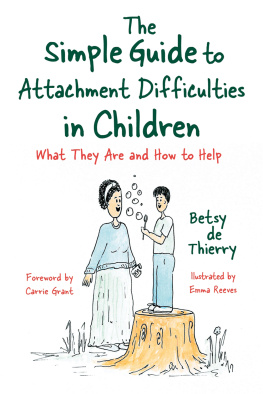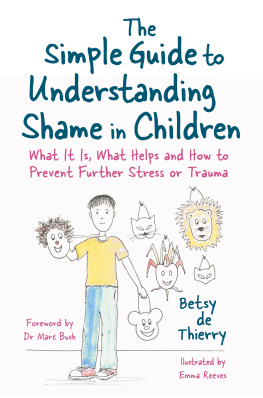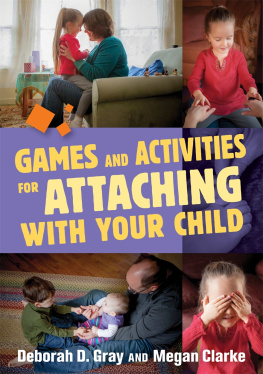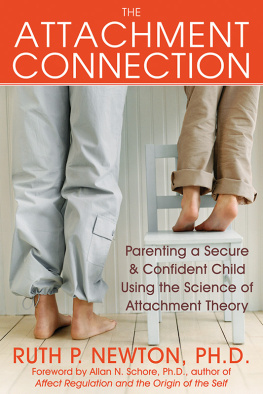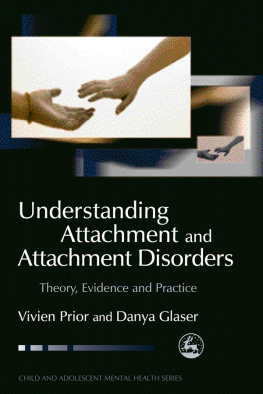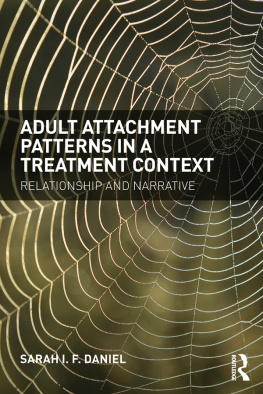
The
Simple Guide to
Attachment Difficulties
in Children
What They Are and How to Help
Betsy de Thierry
Foreword by Carrie Grant
Illustrated by Emma Reeves

Jessica Kingsley Publishers
London and Philadelphia
CONTENTS
FOREWORD
The relationship between parent and child is the most profound of all: in birth, the symbolism of the umbilical cord attaching the supplier to the supplied, the bearer to the born; this other, that is so physiologically close and yet sadly, has the potential to become emotionally, mentally and spiritually disconnected.
As a mum to four children three birth children and one adopted child I have been able to observe different styles of attachment at very close quarters. All our children have special needs, including two autistic girls, and the way in which these incredible children have attached with us and we to them has been a wonderful journey to embark upon. When David and I adopted our son, we thought we had a real advantage with any attachment issues that might arise, as we were already genned-up parents. As vocal coaches, we were attuned to truly hearing people whatever they were saying; we were full of strategies and confident that our love in action could bring this little boy round to a place of feeling safe, held, contained, secure and, most importantly, loved.
What we hadnt accounted for was that it takes two to attach, and we soon found our best efforts were not enough. Hand on heart, I can honestly say I love all my children equally, but restoring attachment demands more than love.
When our son was adopted in 2011, he instantly attached to my husband, David. Our adoption training taught us that adopted children sometimes get to a point where they simply cannot attach any more, so I was overjoyed at our sons ability to connect. Two years into my parenting journey, I was still failing with my son; I felt rejected, and my own inner abandoned child began to surface. I tried harder, but my best efforts were met with silence, defiance and even violence.
And so we started on the long road of discovering about trauma and its effects. We had to learn what we were dealing with. We discovered that the shattering of a childs trust cannot be papered over with a few months or even years of committed, loving parenting. David and I had to get ourselves healed up and tooled up for the battle ahead. What we needed at this point was insight and revelation.
We are now a few years further down the road, and the attachment is definitely there; its secure, and at root level it is permanent. The day-to-day workings can be challenging, but we now have a solid base to work from. My little boy and I are attached.
This easy-to-read book provides the kind of help we were looking for; it lays the problem out clearly and then seeks to offer insight and not trite solutions. Betsy also has a way of making the parent feel as if they can actually get this stuff right. There is no blame and shame, only observation and inspiration.
The reflection points at the end of each chapter are really helpful for conversation and planning. This book could also be used in groups to train and support one another. How I wish we had had this book to study before we adopted.
Carrie Grant
INTRODUCTION
Attachment is such an important subject because living a full life has to involve relationships. We are born totally dependent on relationships for survival and spend the majority of our life working and living alongside others. Whilst relationships can cause huge pain and turmoil, they are also important to really feel alive.
This book is a simple guide to attachment. As in my previous books, I feel immense pressure to draw attention to so many theorists and experts in this field who have spent years researching and developing theories and yet I have to resign myself to knowing that I can only mention some and explore them less than Id really want to. I hope youll understand that the aim and intention of this book is to give an overview, to help those who are unable to study the rich literature out there in depth. Its an overview that I hope people can apply to their homes and workplaces immediately with ease. I am sorry if I havent covered all that you needed me to; it was difficult to keep this short and simple. I do feel that this book needs to be accompanied with The Simple Guide to Child Trauma (2016) and T he Simple Guide to Understanding Shame in Children (2018), and together the three books combined will enable a more thorough understanding.
As with all my books in this series, the majority of the content is still applicable to people of any age despite the focus on children. Ultimately, no matter what age we are, when we have been hurt in a relationship, real healing has to come from a relationship. The older we get, the more complex and multi layered our coping mechanisms can become and so the longer it can take to unpick and unpack those in order to rewire our brains to heal. But healing is very possible, and comes in a similar way through relationships, self-awareness and processing negative experiences.
I do hope that the book helps you as you seek to change lives by offering relationships that are consistent, kind, nurturing, empathetic and emotionally available.
Lets be committed to building communities where there is no shame or blame, but instead support, emotional connection, empathy and kindness.
Well done for all that you are doing! Thank you on behalf of the children that you are reading about keep going and one day they may well write to say how much you impacted their lives.
Betsy
Chapter One
WHAT IS ATTACHMENT?
Attachment is a word that is used to describe the ability to enable a child to feel emotionally and physically safe through their relationship with their main adult(s) who care for them. Attachment theory was first developed by a psychologist called John Bowlby (1988), who was fascinated by the early relationship between babies and their mother and how much that affected them as they grew up. The concept has developed from being solely about a mother and her baby to cover the whole experience of a childs ability to feel intrinsically emotionally safe with their primary carer(s).
My assumption is that you are reading this book because you care about a child and want the best for them. It could be that you are a birth parent who has experienced trauma and you recognise that your child(ren) have been affected by that difficult time and you want to be able to see them recover and heal. Maybe you are an adoptive parent who is focused on developing a positive and healing relationship with your child(ren). You could be a foster parent or teacher or Teaching Assistant (TA) who is working with children who need you to help them heal from past difficult relational experiences. Maybe you are a youth worker, parenting worker or another member of the workforce who is focused on helping children and young people heal from difficult experiences that have caused them to behave in ways that are challenging.
In the childrens workforce the word attachment is becoming used frequently and so the exact definition is important as we explore the concept in this little book. I have offered my definition and here are those of some other professionals:
Attachment is one specific aspect of the relationship between a child and a parent with its purpose being to make a child safe, secure and protected. (Benoit 2018)
An attachment is a precise term: the notion of a safe haven, which, when available, becomes a secure base from which to explore the world around us. Then when we are separated from our secure base we become anxious and quickly seek proximity. (Shemmings 2016a)
Next page
